medieval Church 1073 to 1309
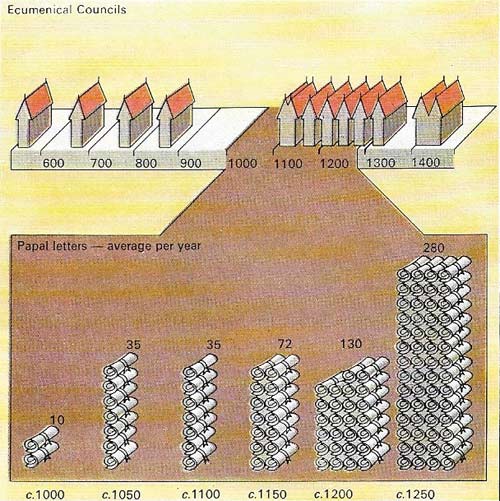
Figure 1. Ecumenical countries, meetings of representatives of the whole Church,reached a peak in the 1100s and 1200s. As the Roman Church established its role as religious authority and arbiter of political events its administrative function developed: the ecumenical council grew and litigation at the Roman courts increased, as did the correspondence of the Curia, the juridical, legislative, and administrative offices of the Papacy. Papal correspondence, a record of ecclesiastical intervention, grew from 130 letters during Adrian IV's Papacy (1154–1159) to 3,646 during John XXII's (1316–1334).
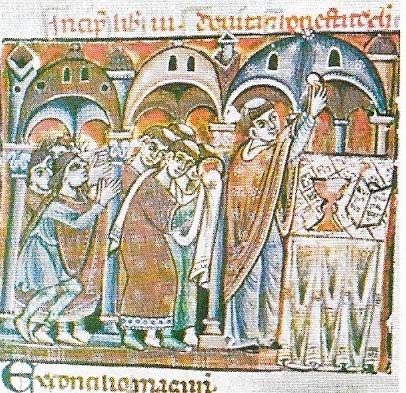
Figure 2. The Decretals of Gregory IX, the manuscript from which this miniature is taken, show the importance attached in the 13th century to the doctrine of transubstantiation. This was made the official teaching of the Church by the 4th Lateran Council (1215) which also prescribed annual confession. Gregory IX patronized the new monastic orders and canonized Dominic, Francis, and Anthony.
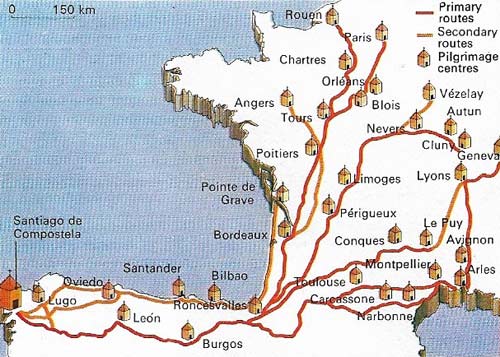
Figure 3. The pilgrimage was the "package tour" of the Middle Ages; pious Muslims went to Mecca just as devout Christians sought to go to Rome, Compostela, or Canterbury. The pilgrimage was at once the fulfilment of an active religion and also the experience of a lifetime. In the early Middle Ages the focus of Christian pilgrimages was Rome; but the gradual appearance of famous relics around the Western world led to a proliferation of shrines, the most famous of which was the of the body of the apostle James at Compostela in Spain. The pilgrimage route to Compostela became a thoroughfare along which many famous Romanesque churches were constructed.
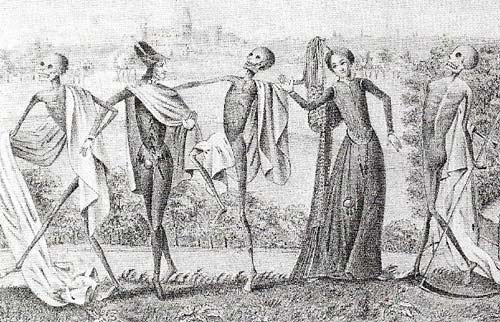
Figure 4. The Dance of Death or danse macabre shows death in the role in which he appeared in late medieval popular mythology. He was seen to be an immediate tangible threat, a maleficent joker. Although many of the precepts of Christianity which are emphasized today appear to have been ignored in the early Middle Ages, it was the common religion of all in the West, and death for the Christian was the consummation of life. Death was therefore prominent in contemporary hagiography and was personified in the popular religious mystery plays. Awareness of death was intensified by the various catastrophes of the 14th century, especially the Great Plague of 1348 which depopulated Europe.
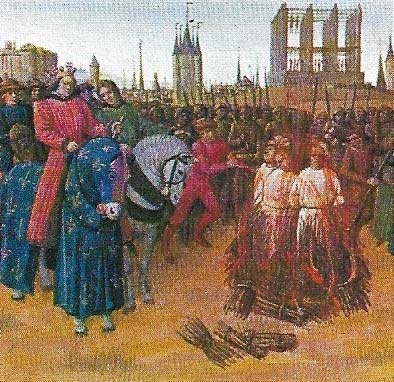
Figure 5. Some followers of Amalric of Chartres were burnt at the stake in the early 12th century for believing that those in love with God partake in His perfection and are proof against sin. Traditionally it was the business of the Church to presence orthodoxy; the ecclesiastical authorities, the Dominicans and Franciscans in particular, investigated heresy, the secular powers punished it.
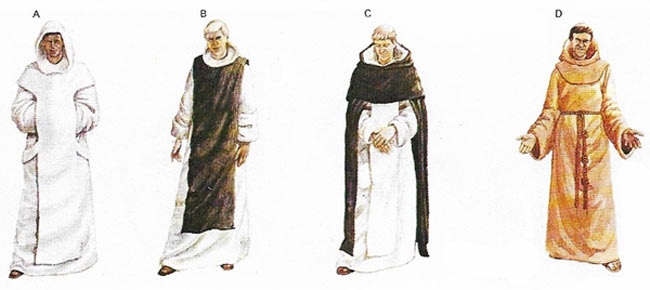
Figure 6. The religious orders increased greatly in number as a result of popular piety and the growing complexity of Church organization. The Cluniac reformers of the 10th century merely tightened the Benedictine Rile. The Carthusians (A), founded by St Bruno in 1084, and the Cistercians, the "white monks" (B), lived according to new rules that emphasized the virtues of self-denial and the strictest religious observance. The orders of friars, the Dominicans (C) and Franciscans (D), were a new kind of wandering priest who travelled Europe preaching, possessing neither property nor money and relying on begging for a livelihood. The original appeal of St Francis, both ascetic and poetic, was unacceptable to the Papacy, because a large body fulfilling an important function needed corporate property if it was not to become socially subversive. Despite opposition from loyal followers, the friars soon obtained property and became an integral part of the Church.
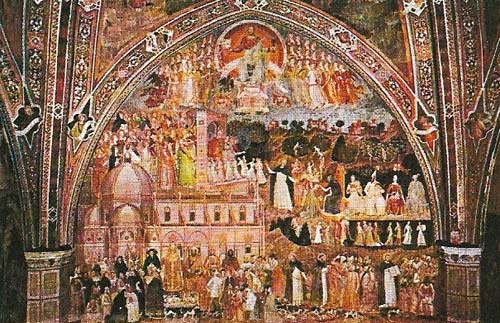
Figure 7. This fresco illustrates the triumph of the Church as seen through the eyes of the late 14th-century Florentine artist Andrea di Buonaiuto. It is in the Chapel of the church of Sta Maria Novella in Florence and is a contemporary commentary on the development of the structure of the Church as a vast international organization with a role in administration and religious teaching. Sta Maria Novella is a Dominican church and the picture emphasizes the role of the Dominican friars, many of whom had been made permanent commissioners for the extermination of heresy, the origins of the Holy Inquisition, under Gregory IX. Dominican friars are shown as the domini canes, "hounds of the Lord".
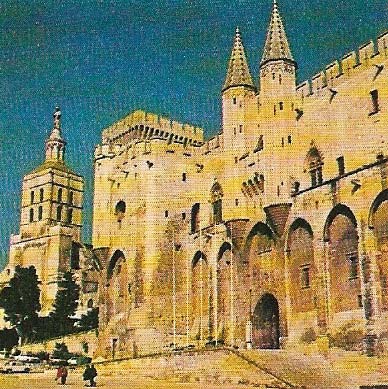
Figure 8. The Papal Palace in Avignon was a more efficient center of papal government than Rome, and it is testimony to the wealth, success, and culture of the papal court in captivity. After two centuries of great power, the Papacy entered a period of submission to temporal rulers when from 1309 to 1377 it was forcibly removed to Avignon. Ostensibly the move was to resolve the conflicts it had suffered in Rome; but the influence of the French monarchy over the Papacy increased.
The years from the accession of Gregory VII in 1073 to the removal of the Papacy to Avignon in 1309 saw the highest achievements of the medieval Christian Church in all its spheres of activity. Western Christendom could genuinely be seen as a unity with about 500 bishoprics all working as part of an international papal system that became ever more organized and powerful. Roman Christianity laid the ground rules for everyone in European society, rules from which only the Jews were exempt. The twelfth and thirteenth centuries also saw the triumph of Gothic architecture and decoration, an achievement paralleled by the complete codification of law, knowledge and philosophy in a Christian theological context by the scholastic philosophers, St Thomas Aquinas (1225–1274) in particular.
The power of the Papacy
The 11th-century Papacy had been inspired by the example of Cluniac reform, demonstrated best in the Lenten Synod at Rome in 1074 which laid down strict rules for the appointment and behavior of the clergy. The following year Gregory VII formally prohibited lay investiture (the appointment of bishops by a secular ruler), which not only antagonized Emperor Henry IV (reigned 1056–1106), but generally incurred violent hostility throughout Germany, France and England. The resulting battle made it necessary for the Papacy to indulge in extensive legal justification of its position and led eventually to an institutionalized Papacy that would have been abhorrent to the original Cluniac reform.
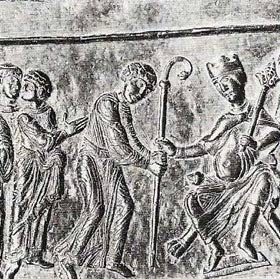 |
| The question of who should invest bishops caused a rift between popes and secular rulers. Great local wealth and political power went with the office of bishop, the sort of wealth with which any ruler would want to reward or bribe a useful servant. This bronze depicting Emperor Otto I investing Bishop Adalbert of Magdeburg in 962 demonstrates the imperial position at its strongest. The new bishop is seen receiving his authority from the secular ruler, not the pope. |
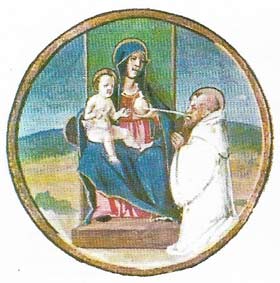 |
| This miniature of St Bernard of Clairvaux (1090–1153) being nourished by milk from the breast of the Virgin Mary is taken from a 15th-century Venetian Cistercian breviary. It exemplifies one of the chief tenets of St Bernard's teaching, an almost sentimental devotion to the mother of God. The reverence of Mary was one of the striking elements of popular piety in the 12th century. |
The pope claimed to be the supreme judge and moral arbiter in temporal disputes. Only in this period could Emperor Henry IV have been humbled at Canossa by Gregory VII; could so powerful an English king as Henry II have appeared at Canterbury in a hair shirt to atone for the murder of Thomas Becket; could King John (reigned 1199–1216) have been forced to submit himself (and the English crown) as a vassal of Pope Innocent III ; or could Innocent IV have been able to annihilate the Hohenstaufen line of emperors in 1250.
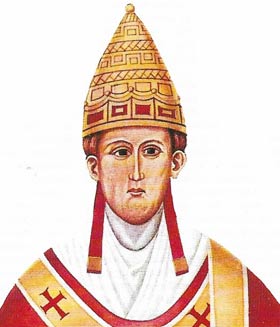 |
| Pope Innocent III (c. 1160–1216), a brilliant jurist, was trained at the universities of Paris and Bologna. His ambition and administrative gifts brought the medieval Papacy to the height of its powers. Through the legislative power of the papal Curia, his tight control of ecclesiastical affairs throughout Europe and his influence in imperial elections, Innocent fulfilled for a time the papal ambition of directing the affairs of the entire secular European world. |
The most imposing instrument of papal government was the Ecumenical Council, a decision-making body of all the bishops of Western Christendom summoned to attend at the request and direction of the pope. There were no fewer than seven such councils during the years 1123 to 1312.
Papal administration
The growth of the Curia, the administrative focal point of the Vatican, also led to its increasing use as an international court of law. By the 13th century the ecclesiastical nature of the Papacy was at times overshadowed and popes such as Innocent IV (reigned 1243–1254) were lawyers and administrators rather than religious leaders. The Papacy became increasingly embroiled in international politics, a development which culminated in its forcible transference to Avignon by the French monarchy from 1309 to 1377 (Figure 8).
In contrast to the growing complexity of papal administration there was a wave of reforms within the religious orders, all of which were based on piety, simplicity and austerity. Despite the Cluniac reforms, the Benedictine Order had lost its pious intensity by the early 12th century. The constitution of the Cistercians, the Charter of Love, written by St Stephen Harding in 1119, was an adaptation of the Benedictine Rule based on a denial of ostentation and an austere life located away from centres of population. The response to this rigorous life of prayer was overwhelming and 530 Cistercian houses had been established by 1200. Another offshoot of the Benedictine system were the Carthusians, founded by St Bruno at the monastery of the Grande Chartreuse in 1084.
There were many other new orders in the 12th century – Augustinian canons, hermits, Hospitallers, crusading orders, Templars and organizations for the visitation of the sick and the imprisoned. The ultimate in clerical reform was the foundation of the Friars (Figure 6). St Francis of Assisi (1181–1226) and St Dominic (c. 1170–1221) both stressed that their followers should take vows of complete poverty, and that neither individuals nor the order as a whole should possess any property. Friars were by definition to live by the work of their hands and, if necessary, by begging. They were to preach and exhort and to set a visible example of self-denial. By the fourteenth century, however, the orders denied their founders' intentions, held communal property and became part of the structure of the Church.
The twelfth and 13th centuries were ages of secular piety and involvement with the Church as well as clerical reform. The Crusades were central to religious activity as were pilgrimages to Rome. Compostela in Spain (Figure 3), Canterbury and local shrines.
Persecution of heretics
The ugly side of the universality of papal pretensions and the increasing extremes of the religious life was the persecution of heretics (Figure 5). The Jews, as non-believers, were largely left alone at this time, but heretics, as deserters from the true faith, had to be reconverted, by force if necessary. Among those heretics were the Albigensian, who held all material things and social life to be evil, thus presenting a challenge both to the Church and to the stability of society. The Albigensians were destroyed in the 1200s.
